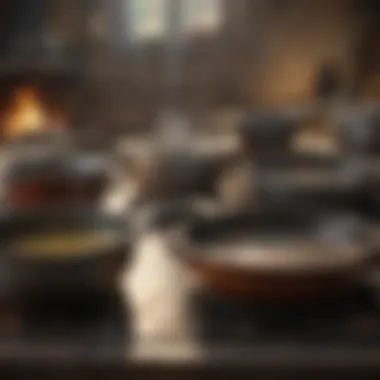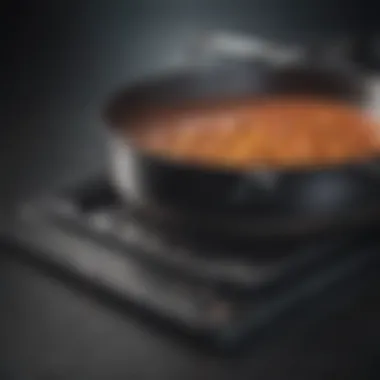Exploring the Multifaceted Nature of the Pan Can


Intro
The pan can is often overlooked in discussion of culinary tools, yet its significance is substantial. It serves not only as a cooking instrument but also as a focal point for various scientific and environmental considerations. Many individuals might not realize the complex history and evolution of this essential tool. In this article, we aim to explore its multiple dimensions, including culinary applications, material properties, and environmental impact. Understanding these factors can provide valuable insights into the choices we make in the kitchen.
Research Overview
Methodological Approaches
To delve deep into the pan can's multifaceted nature, various methodological approaches are employed. Literature review and comparative analysis are foundational methods. They help illuminate historical recipes, technological developments, and shifts in materials used in pan production. Interviews with chefs and culinary experts add personal insights, revealing how the choice of pan influences cooking techniques and flavors. Furthermore, experimental studies assess how different materials, like stainless steel or non-stick coatings, perform in terms of health and cooking efficiency.
Significance and Implications
The implications of our findings are manifold. Each choice of pan affects not only the cooking experience but also health outcomes and environmental sustainability. For instance, awareness about materials can lead to safer kitchen practices. Moreover, understanding how choices intersect with culinary traditions provides a richer context for contemporary cooking.
Current Trends in Science
Innovative Techniques and Tools
Recent innovations have made significant impacts in the world of cookware. Non-stick coatings and ceramic finishes are not the only advancements. Emerging technologies within material science have led to lighter, more durable options. Innovations like induction-ready pans demonstrate the integration of modern cooking methods into pan designs. These advancements require ongoing examination to ensure they meet health standards while performing optimally.
Interdisciplinary Connections
Understanding the pan can involves connections to various fields. From material science to gastronomy, the relationship between different domains is evident. Culinary experts, engineers, and environmental scientists all contribute knowledge that influences how we view and use the pan. Relationships in these disciplines enhance our comprehension of not just cooking, but of how our tools shape the cooking process as well.
"The pan can is more than just a kitchen tool; it is a vessel where science meets the art of cooking."
Through this exploration, we aim to enrich the conversation around the pan can, fostering appreciation for its essential role in both culinary practices and broader societal issues.
Prologue to the Pan Can
The pan can is a staple in kitchens worldwide. It serves various functions that go beyond mere cooking. Understanding the pan can is essential for anyone involved in culinary practices, whether a professional chef or a home cook. This section aims to unravel its complexities, highlighting its structural design, material composition, and role in food preparation.
Definition and Overview
The term "pan can" refers to a type of cooking vessel designed for diverse culinary techniques. Typically, it is characterized by a flat, circular base and low sides. This shape is effective for sautéing, frying, and braising. Often made of various materials, the pan can is versatile enough to handle different cooking styles. The size of the pan can ranges from small individual units to larger family-size versions. The cooking surface can also vary, with some models featuring non-stick properties. Knowing these aspects provides a foundation for understanding how to maximize its potential in the kitchen.
Significance in Culinary Culture
The pan can is not just a tool but a significant element in culinary culture. Throughout history, its evolution mirrors culinary trends and technological advancements. Many cultural traditions center around specific dishes prepared in pans. For instance, the French sauté pan is integral to classic French cuisine, while the Chinese wok plays a vital role in stir-frying.
Importantly, the pan can also influences food preparation techniques. It dictates heat distribution and retention, which can affect the final taste and texture of a dish. Highlighting its impact in various global cuisines shows its relevance beyond local cooking practices.
Moreover, the accessibility of pan cans contributes to cooking democratization. They are available in various price ranges, making them accessible to a wide audience. This accessibility encourages culinary exploration and experimentation. In summary, the pan can's multifaceted nature makes it indispensable in both a practical and cultural context.
Historical Context
Understanding the historical context of the pan can is essential to grasp its significance in culinary art and technology. This section will outline the journey of cooking vessels from their rudimentary beginnings to the sophisticated designs we encounter today. The evolution of the cooking pan reflects broader societal changes, technological advancements, and cultural exchanges. Therefore, it is crucial to analyze how these transformations have influenced cooking practices worldwide.


Evolution of Cooking Vessels
The evolution of cooking vessels is a fascinating tale rooted in human innovation. Early humans utilized simple stones and clay to prepare food. As time progressed, they began to forge metal, allowing for the creation of more durable and versatile pans. The Greeks and Romans were notable for their advancements in metalworking. They introduced bronze and iron pans, which provided significant improvements over their stone and clay predecessors.
In different cultures, the development of cooking vessels followed unique paths. For example, in Asia, woks made of carbon steel became an integral part of culinary practice. They allowed for quick cooking over high heat, a technique that significantly changed meal preparation. Similarly, in Europe, cast iron pans emerged, known for their heat retention and rustic charm, contributing to traditional cooking styles.
The Industrial Revolution marked a pivotal moment in cookware history. Mass production techniques enabled the creation of affordable and consistent kitchenware, allowing households to modernize cooking practices. During this period, non-stick coatings, such as Teflon, were also introduced, revolutionizing how food could be prepared while minimizing the need for fats.
Cultural Variations in Pan Design
Cultural variations in pan design represent a rich tapestry of culinary traditions and functionality. Each region's unique approach to pan design reflects the local cooking methods, available materials, and culinary preferences.
- Asian Woks: These pans are characterized by their wide, shallow shape and high sloping sides. They are highly versatile, used for stir-frying, steaming, and even deep frying. The design emanates from a strong cultural emphasis on high-heat, quick cooking.
- French Skillets: Known for their flared edges and sometimes made of copper, they excel in techniques requiring precise temperature control. The French culinary approach often involves sauce-making, and skillets are designed to facilitate this process.
- Cast Iron Griddles in Southern United States: This pan serves both frying and baking functions, capturing the essence of Southern cuisine. Influenced by African culinary techniques, it enhances flavors through its heat retention properties.
- Indian Tawas: Flat, round cast iron pans used for cooking bread like roti or dosa. Their specific design caters to the high-heat cooking styles predominant in Indian kitchens.
These variations are not merely aesthetic; they serve specific culinary functions that enhance the tastes and quality of the food prepared. They are a testament to the cultures they originate from, making the study of pan designs integral to understanding global culinary practices.
"The evolution of the pan is not just a story of materials; it's a reflection of how societies cook, celebrate, and share food."
In summary, the historical context of the pan can encompasses the evolution of cooking vessels that have emerged from various cultures. These advancements reveal much about societal values, resource utilization, and the timeless quest to perfect culinary techniques. Understanding this history can enrich our appreciation for the designs and functionalities of contemporary pans.
Materials Used in Pan Construction
The materials used in the construction of pans significantly influence their performance, durability, and safety. Understanding these materials is crucial for making informed choices in both home and professional kitchens. Factors such as heat conductivity, weight, maintenance, and reactivity with foods all depend on the materials selected for each type of pan. This section delves into these important considerations, examining various metal types, the role of coatings, and advances in materials technology that affect everyday cooking.
Types of Metals and Their Properties
Metal is a fundamental component in cookware design. Each type brings unique properties that cater to several culinary needs. Here are some common metals used in pan construction:
- Stainless Steel: Known for its durability and resistance to rust, stainless steel does not react with acidic foods, making it suitable for a variety of cooking applications. It conducts heat relatively well but may not distribute it as evenly as some alternatives.
- Aluminum: This metal is lightweight and offers excellent heat conductivity. However, it tends to warp and scratch easily and can react with certain foods. Anodized aluminum can help mitigate these issues by creating a non-reactive surface.
- Copper: Renowned for its superior thermal conductivity, copper allows for precise temperature control. Nonetheless, it requires regular maintenance to prevent tarnishing and is often lined with stainless steel to prevent reactions with food.
- Cast Iron: Cast iron retains heat exceptionally well. It requires seasoning to maintain its non-stick surface and can react with acidic foods, leading to changes in flavor.
Each metal has specific usages and is chosen for its particular qualities. The key lies in understanding these differences to select the appropriate pan for each cooking task.
Non-Stick Coatings and Their Chemistry
Non-stick coatings are essential for preventing food from adhering to pan surfaces. They offer convenience and simplify the cooking and cleaning process. Most commonly, polytetrafluoroethylene, known as PTFE, is used for non-stick applications. The chemistry behind non-stick coatings is fascinating:
- PTFE: This polymer provides a smooth surface that reduces friction, preventing food from sticking. It withstands high temperatures but can degrade if overheated.
- Ceramic Coatings: These are derived from sand and provide a natural non-stick surface. They are chemical-free and often marketed as safer alternatives to traditional coatings, although they may require more careful handling.
- Composite Coatings: Combining different materials, these coatings may include titanium or diamond particles to enhance durability and heat resistance. However, they can still suffer wear over time, limiting their lifespan.
It is crucial to consider the safety of non-stick coatings in relation to health. Understanding the chemistry helps consumers make educated decisions about the cookware they choose.
Emerging Materials in Pan Technology
Innovation has led to the development of advanced materials that enhance pan performance and sustainability. Some notable trends include:
- Graphene: This material has emerged in cookware for its remarkable heat conductivity and lightweight properties. Research is ongoing to determine its long-term benefits in pans.
- Recycled Metals: Sustainability concerns have spurred the use of recycled metals in cookware. These materials can often match the quality of new metals, promoting environmental responsibility without compromising performance.
- Bio-based Non-Stick Coatings: Newer coatings fashioned from organic materials help reduce environmental impact while maintaining non-stick and non-toxic properties.
Culinary Applications
Culinary applications of the pan can are crucial for understanding its functionality and impact on cooking. The choice of the right pan can significantly influence the outcomes in culinary practices, from taste to texture. Each material and design offers different benefits, which can enhance or hinder the cooking process.


Techniques for Optimal Use
To fully utilize the pan can, several techniques should be adopted. Proper preheating is essential; it ensures even distribution of heat, preventing hot spots that could lead to uneven cooking. Utilizing oil or fat without overheating can enhance the non-stick properties of the pan, allowing for easier food release.
Additionally, it is important to know the optimal temperature for different cooking tasks. For instance, when sautéing vegetables, a medium-high heat works well. Maintaining a constant temperature improves the cooking performance, resulting in food that is properly cooked and retains its nutrients.
Cleaning and maintenance also play a role in the longevity and performance of the pan. Using non-abrasive tools and mild detergents helps preserve the surface integrity. Regular seasoning, especially for cast iron pans, can enhance their non-stick performance and extend their lifespan.
Choosing the Right Pan for the Recipe
Choosing the correct pan for a specific recipe is paramount. Different cooking methods demand different designs and materials. For example, a stainless steel frying pan is ideal for browning proteins due to its excellent heat retention and distribution. On the other hand, a non-stick pan is preferred for cooking delicate items like eggs and pancakes, as it reduces the risk of sticking.
When selecting a pan, consider the following factors:
- Material: Choose based on heat conduction and reaction with food. Materials range from ceramic to stainless steel, each offering unique advantages.
- Size: The size of the pan matters. A larger pan allows for more even cooking of larger batches, while smaller pans are efficient for single servings.
- Shape: Some dishes require specific shapes, like deep pans for stews or shallow ones for frying.
The right pan can elevate a recipe, directly impacting flavor and presentation.
Health Considerations
In the discussion of cooking pans, health considerations play a pivotal role in understanding their impact on both food preparation and overall well-being. The materials used in construction, the techniques employed while cooking, and the longevity of these pans all intersect with health factors that cannot be ignored. Recognizing the significance of these factors helps consumers make informed decisions that align with their dietary and environmental values.
Material Safety and Toxicity
When it comes to pan safety, the choice of materials is a fundamental concern. The presence of certain chemicals in cookware can potentially leach into food, leading to health risks. For example, traditional non-stick pans often contain polytetrafluoroethylene (PTFE) or perfluorooctanoic acid (PFOA). While PTFE is generally considered safe at lower temperatures, overheating it can release toxic fumes. Meanwhile, PFOA, which is being phased out, has been linked to various health issues, including hormonal disruptions and cancer.
The shift towards ceramic, stainless steel, and cast iron options has become increasingly popular. These materials are perceived as safer alternatives. They do not contain harmful chemicals, although the safety of ceramic coatings can vary based on manufacturing processes. Understanding what to look for in health-compliant materials is crucial for consumers.
"Knowing the material composition of your cooking pan is essential for ensuring the safety and quality of the food prepared."
Choosing products labeled as free from harmful substances, such as BPA and aluminum, can also promote healthier cooking practices. Awareness of the cookware's origin and its manufacturing process adds another layer of evaluation concerning safety and toxicity.
Impact of Cooking with Different Pans
The impact of using various types of pans extends beyond mere cooking performance; it also encompasses health outcomes. Different materials conduct heat differently, which can change how food is cooked and ultimately the nutrients preserved. For instance, cast iron pans can enhance iron intake when cooking acidic foods, while stainless steel might not offer the same benefit.
Furthermore, the technique used in cooking with certain pans can alter the healthiness of the prepared dish. High temperatures can lead to the formation of acrylamides, particularly in non-stick pans that are subject to overheating. On the other hand, certain pan types are more suitable for methods like braising or slow cooking, allowing for moisture retention and nutrient preservation.
In contrast, non-stick pans may simplify clean-up and reduce the need for fats during cooking, which could potentially lower caloric intake. However, understanding the chemical reactions and the health ramifications of each type of pan is vital in optimizing your cooking habits. It is advisable to remain informed about your pans and adjust cooking techniques based on the characteristics of the cookware utilized.
Environmental Impact
Understanding the environmental impact of kitchenware, particularly the pan can, is crucial in today’s context of sustainability. As more consumers prioritize eco-friendly products, manufacturers are responding by adopting practices that minimize ecological harm. The production, use, and disposal of kitchenware not only affect the environment but also influence human health and global resources.
Sustainable Manufacturing Practices
Sustainable manufacturing practices focus on reducing waste, conserving energy, and minimizing harmful emissions throughout the lifecycle of kitchenware. For the pan can, this can involve several key elements:
- Material Selection: Opting for eco-friendly materials, such as recycled metals or sustainably sourced non-stick coatings, can significantly lessen environmental impact. Traditional aluminum, for instance, can be sourced with responsible mining practices to reduce habitat destruction.
- Energy Efficiency: Manufacturers are adopting energy-efficient technologies that lower energy consumption during production. This includes using renewable energy sources, such as solar or wind, for powering factories.
- Waste Management: Effective waste management strategies during production not only reduce environmental footprints but also lower costs. Scrap metal can be recycled rather than discarded, and by-products can be repurposed for other applications.


Implementing these practices leads to lower carbon footprints and helps conserve resources, making sustainable pan production a viable option for modern kitchens.
End-of-Life Considerations for Kitchenware
As consumers increasingly consider the full lifecycle of their purchases, end-of-life considerations for kitchenware, including the pan can, have gained attention. How a product is disposed of can have lasting effects on the environment:
- Recyclability: Many pans can be recycled, but awareness is crucial. Users should check local recycling guidelines to ensure they dispose of the pan properly. Metal pans, such as those made from stainless steel or aluminum, are often recyclable; non-stick pans may require specific procedures.
- Landfill Impact: If not disposed of correctly, kitchenware can contribute to landfill waste. Products made from non-recyclable materials can persist in landfills for decades, leading to soil and water pollution.
- Upcycling Opportunities: Consumers can also consider creative ways to repurpose pans that are no longer functional. For instance, old pans can serve as planters or decorative items in a garden or home.
"Every choice matters when it comes to the environment. Opting for sustainable options today can create a healthier planet for future generations."
Considering these factors allows consumers and manufacturers to make informed decisions that prioritize environmental sustainability. As the discourse around responsible consumption grows, so too does the importance of considering the environmental impact of kitchenware like the pan can.
Technological Advances
Technological advances in the realm of cooking appliances have greatly changed how culinary practices are approached. Innovations in the design and manufacture of cooking pans have led to improvements that impact both efficiency and effectiveness in modern kitchens. Embracing these technological changes is crucial for anyone who wants to enhance their cooking skills or make informed decisions about kitchen equipment.
Smart Pans and Cooking Technology
The emergence of smart pans signals a significant shift in culinary technology. These pans often come equipped with sensors that monitor temperature and cooking time. Such features allow for a more precise cooking experience. For instance, a smart pan can connect to an app on a user’s smartphone. This connection enables guided cooking sessions, where recipes can be followed with accuracy. Users can receive alerts when it is time to flip or stir, helping to achieve consistent results.
The inclusion of smart technology introduces several advantages:
- Precision: Cooking becomes more reliable with real-time feedback on temperature and cooking state.
- Energy Efficiency: Smart pans can optimize heat usage, reducing electricity consumption.
- Recipe Assistance: They can store user preferences and suggest recipes based on available ingredients.
However, there are also considerations to take into account.
- Users must be comfortable with technology and willing to embrace digital tools in the kitchen.
- Initial costs for smart pans can be higher than traditional options, which may be a barrier for some.
Innovations in Heat Distribution
Innovations in heat distribution are another key area of advancement. Many new cooking pans utilize research in materials science to enhance heat conduction. For example, pans made from copper or aluminum distribute heat more evenly than traditional cast iron. This even heat distribution reduces the risk of hotspots that can lead to uneven cooking.
Several features characterize modern innovations in heat distribution:
- Thermal Technology: Recent developments can maintain consistent cooking temperatures throughout the surface regardless of flame intensity.
- Layering Techniques: Use of multiple materials in construction, like stainless steel with a copper core, provides superior heat control.
- Non-Stick Properties: Modern pans have built-in non-stick surfaces that can also aid in uniform heating while preventing food from adhering and burning.
Ending
The conclusion serves as an essential recap, tying together the various threads explored in this article about the pan can. It encapsulates the critical aspects of the pan's multifaceted nature—its historical evolution, material science implications, culinary applications, health considerations, environmental impact, and advancements in technology. Each of these areas contributes to a broader understanding of how the pan can influences both our kitchens and our health.
Understanding the importance of the pan goes beyond its functional role. It represents a convergence of tradition and innovation, where chefs and home cooks alike navigate choices that affect both culinary outcomes and well-being. The fundamental role of the pan can fosters a mindful approach to cooking, challenging the user to consider the impact of their decisions on health and sustainability.
By synthesizing the information gleaned from each section, we can appreciate the intricate relationship between cooking practices and the tools employed. The pan can, mundane in its everyday use, transforms into a symbol of culinary artistry and environmental consciousness.
Recap of Key Points
- Definition and Overview: The pan can is more than a cooking vessel; it is a versatile tool integral to culinary practices.
- Historical Context: The evolution of the pan reflects changes in technology, materials, and cultural practices across different societies.
- Materials Used in Construction: The choice of materials significantly impacts the pan's performance, safety, and environmental footprint.
- Culinary Applications: Techniques for using a pan vary, affecting the outcome of culinary tasks and dish quality.
- Health Considerations: Awareness of material safety and potential toxicity informs healthier cooking choices.
- Environmental Impact: The manufacturing and disposal processes of pans raise questions about sustainability and product lifecycle.
- Technological Advances: Innovations in smart cooking technologies push the boundaries on how pans will be used in the future.
Future Trends in Pan Development
The future of pan development is poised to align with broader trends in sustainability, health, and technology. Anticipated innovations may include:
- Eco-Friendly Materials: New non-toxic materials that reduce environmental impact while maintaining cooking integrity.
- Smart Technologies: Integration of sensors to monitor cooking conditions and optimize heat distribution.
- Customization Options: Pans designed to accommodate specific cooking methods, such as induction or conduction.
- User-Centric Designs: Greater emphasis on ergonomics and user experience, making pans easier to handle and clean.
These trends indicate a future where the pan can evolves beyond its traditional role, adapting to modern lifestyle demands and encouraging healthier cooking practices. As consumers become increasingly aware of their choices, the pan can is set to represent not just a cooking tool, but a statement of values in health, ecology, and technology.



